2. Nemesis (Alton Towers)
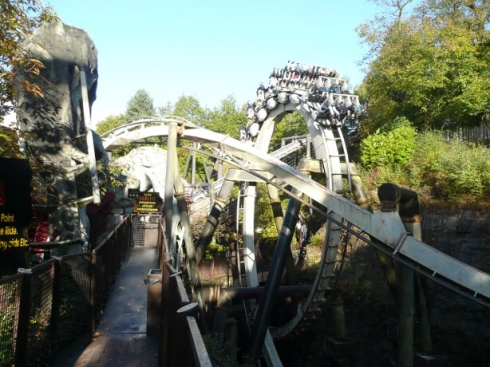 Alton Towers, the most popular theme park in the UK, faces some of the biggest restrictions of any theme park when adding new rides. Because the park is built in grounds of a decaying gothic mansion, heritage authorities enforce strict rules on what is and isn't allowed. For example, no rides are allowed to be taller than the tree-line - which makes building world-class roller coasters a little difficult. After the Tussauds Group bought Alton Towers in the early 1990s, it was determined to add a major new coaster in spite of the restrictions. It turned to legendary designer John Wardley, who was keen to create a unique, custom experience that could not easily be replicated elsewhere. His biggest issue was how to achieve this within the strict planning constraints placed on the park by the authorities. "We probably have the most trouble of any park in the world when it comes to getting planning consent", Wardley explained during a presentation to mark Nemesis’ tenth anniversary. "It’s dead easy to build a high roller coaster. We had a huge problem. Our site here at Alton Towers does not allow us to build big, high rides. We couldn’t build anything that went above the trees. We couldn’t build anything that could be seen from outside the park. How on earth could we build a sensational, world-class roller coaster when we had to keep the thing no higher than the tallest tree on site?" Wardley and his team floated helium balloons above the site, in order to establish the maximum height of the coaster. It rapidly became clear that there simply wasn’t enough height available to create the fast-paced experience that Alton Towers needed. The solution was simple: build downwards, into the ground. The team proposed excavating an enormous pit, an unusual approach that would cost a fortune. Management were receptive, though, and so were the local authorities.
Alton Towers, the most popular theme park in the UK, faces some of the biggest restrictions of any theme park when adding new rides. Because the park is built in grounds of a decaying gothic mansion, heritage authorities enforce strict rules on what is and isn't allowed. For example, no rides are allowed to be taller than the tree-line - which makes building world-class roller coasters a little difficult. After the Tussauds Group bought Alton Towers in the early 1990s, it was determined to add a major new coaster in spite of the restrictions. It turned to legendary designer John Wardley, who was keen to create a unique, custom experience that could not easily be replicated elsewhere. His biggest issue was how to achieve this within the strict planning constraints placed on the park by the authorities. "We probably have the most trouble of any park in the world when it comes to getting planning consent", Wardley explained during a presentation to mark Nemesis’ tenth anniversary. "It’s dead easy to build a high roller coaster. We had a huge problem. Our site here at Alton Towers does not allow us to build big, high rides. We couldn’t build anything that went above the trees. We couldn’t build anything that could be seen from outside the park. How on earth could we build a sensational, world-class roller coaster when we had to keep the thing no higher than the tallest tree on site?" Wardley and his team floated helium balloons above the site, in order to establish the maximum height of the coaster. It rapidly became clear that there simply wasn’t enough height available to create the fast-paced experience that Alton Towers needed. The solution was simple: build downwards, into the ground. The team proposed excavating an enormous pit, an unusual approach that would cost a fortune. Management were receptive, though, and so were the local authorities. 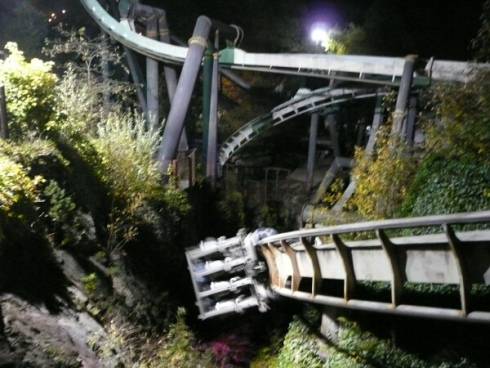 The actual coaster would be a ground-breaking design, too. Wardley had heard that the newly-formed Swiss firm Bolliger & Mabillard were building a prototype coaster for Six Flags Great America near Chicago. He persuaded his friend at Six Flags, Harold Hudson, to put him in contact with the firm - and learned that it was building something totally unique. Wardley was staggered by Hudson’s description of the new attraction. The "inverted coaster" would see riders sitting in trains that dangled beneath the track. Unlike existing suspended coasters, though, the ride’s trains would be “floorless”, with riders’ legs dangling freely beneath them. Not only that, but it would be capable of including loops and other inversions in its circuit – something that existing suspended coasters with their swinging trains, could not do. "That’s impossible," was Wardley’s reply, "you can’t turn an inverted coaster through loops." B&M, though, had found a way.
The actual coaster would be a ground-breaking design, too. Wardley had heard that the newly-formed Swiss firm Bolliger & Mabillard were building a prototype coaster for Six Flags Great America near Chicago. He persuaded his friend at Six Flags, Harold Hudson, to put him in contact with the firm - and learned that it was building something totally unique. Wardley was staggered by Hudson’s description of the new attraction. The "inverted coaster" would see riders sitting in trains that dangled beneath the track. Unlike existing suspended coasters, though, the ride’s trains would be “floorless”, with riders’ legs dangling freely beneath them. Not only that, but it would be capable of including loops and other inversions in its circuit – something that existing suspended coasters with their swinging trains, could not do. "That’s impossible," was Wardley’s reply, "you can’t turn an inverted coaster through loops." B&M, though, had found a way. 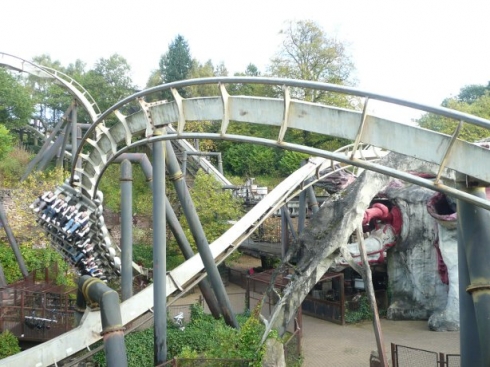 The next challenge was to design a track layout that squeezed as much excitement as possible into the limited footprint imposed by the pit. "Although we curse the various statutory bodies that control Alton Towers’ heritage, they do force us to be creative", Wardley concedes. “It would be so easy and so much cheaper if we could just throw steel up into the air way above the trees." Between them, Wardley and B&M were able to come up with a design that worked, packing four inversions (two corkscrews, a zero-g roll and a vertical loop) into the circuit. The construction of the ride was tortuous, requiring the enormous pit to be blasted out of the rock. Incredibly, the park spent as much on the pit as it did on the coaster itself (some £5 million). It was worth it, though - Nemesis recently celebrated its 20th anniversary, and is still one of the most popular rides in the UK.
The next challenge was to design a track layout that squeezed as much excitement as possible into the limited footprint imposed by the pit. "Although we curse the various statutory bodies that control Alton Towers’ heritage, they do force us to be creative", Wardley concedes. “It would be so easy and so much cheaper if we could just throw steel up into the air way above the trees." Between them, Wardley and B&M were able to come up with a design that worked, packing four inversions (two corkscrews, a zero-g roll and a vertical loop) into the circuit. The construction of the ride was tortuous, requiring the enormous pit to be blasted out of the rock. Incredibly, the park spent as much on the pit as it did on the coaster itself (some £5 million). It was worth it, though - Nemesis recently celebrated its 20th anniversary, and is still one of the most popular rides in the UK.
1. Jaws (Universal Studios Florida)
Image: Universal
Universal Studios Florida opened in 1990, and Universal made the brave decision to dispense with the formula that had worked so well at its original park in Los Angeles. Instead of cloning the Hollywood park's tram tour, it opted to take elements of the tour and blow them up into separate, full-scale attractions. One of those attractions would be based on the Jaws section, itself based on the classie movie directed by Steven Spielberg. In Hollywood, Jaws’ great white shark lunges out of a lagoon at the Studio Tour’s trams. The Florida version of the experience would be significantly expanded and enhanced. Riders would now board flimsy-looking boats, placing them in much greater jeopardy. Jaws would actually grab the boats with his sharp teeth, before dragging it around the lagoon. Even before work started, it was recognized that developing the Jaws attraction would be a hugely complicated undertaking – perhaps more so than any other attraction at Universal Studios Florida. Legendary Disney Imagineer Bob Gurr, then with Sequoia Creative, recalls: "I had no reluctance to decline to bid on giant jobs if I thought the idea was too risky. Once, as a VP in a themed entertainment company, I no-bid on a monstrous job in Florida that had sharks in it." Gurr's decision was to prove to be a wise one. The biggest challenge facing Jaws’ developers was how to enable enormous, life-sized models of sharks to move through a large body of water, with perfect timing so that their movements coincided with those of the boats. Former Universal show producer Adam Bezark recalls: "You can imagine how complex it must be to get one giant mechanical watercraft to swim up and bite another giant mechanical watercraft – which is moving – with absolute precision, hundreds of times per day." The sharks, “swimming” at 20 feet per second, would not only grab the boat, but would then drag it around the attraction’s seven-acre lagoon. Weighing some three tons each and measuring 24 feet in length, they would move through the water with a thrust equivalent to that of a Boeing 747 engine. To enable this, nearly 2,000 miles of electrical wire and 7,500 tons of steel were part of the lagoon’s construction. Computer-guided hydraulic systems were used to control the actions of the sharks. The construction and testing of the Jaws ride was fraught with problems, with the key issue being how to overcome the enormous drag caused by the water when the giant robotic sharks went from a dead stop to a rapid lunge. During testing of the boat attack scene, the shark would often lie in a stationary position at the bottom of the lagoon, refusing to emerge. Other times, its teeth – which were real shark teeth, glued into the model – would rip the pontoons on the boat. In total, MCA spent more than $30 million to produce the Jaws ride, making it one of Universal Studios Florida’s most expensive attractions. However, it was forced to close it just months after opening when it proved unable to operate reliably. It was rebuilt over a period of three years, at a staggering cost of $40 million. 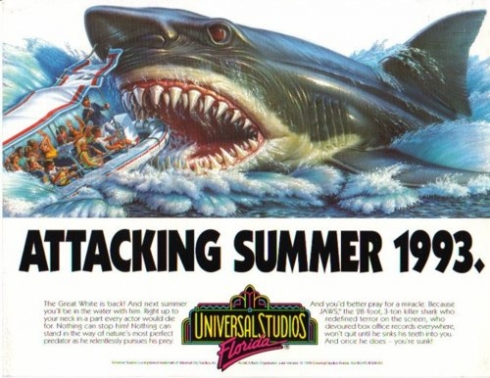
This time around, the company brought in Oceaneering International's Advanced Technologies Group to build the sharks. The company had been contracted by Universal as it was a specialist in building the heavy-duty hydraulic machinery used by undersea oil rigs – its work on the updated Jaws ride would be its first foray into the entertainment business. The Oceanineering International team built no fewer than seven fiberglass-and-steel great white sharks, which proved to be much more reliable than the original versions. At various points during the ride, the sharks surged from the water with a force equivalent to a 500-horsepower engine. All of the underwater equipment was encased in hard plastic to prevent corrosion. To achieve their rapid forward lunges, each of the sharks was attached to a hydraulic lift. This apparatus, weighing 12 tons, was mounted on a wheeled platform, enabling the sharks to move around the lagoon. The platforms themselves sat on underwater tracks. The updated Jaws ride debuted in August 1993, but was officially categorized as undergoing “technical rehearsals” until early 1994. It continued to thrill guests until its removal to make way for the Wizarding World of Harry Potter - Diagon Alley, which is due to open in summer 2014.
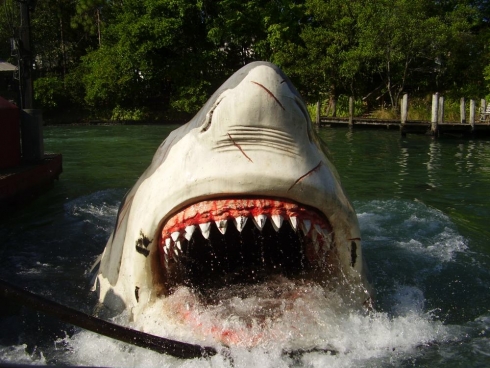

Comments
Even though I am a die hard Disney fan, I think Spider Man is one of the most awesome rides ever conceived.
I'd be interested to see where 'X' at Six Flags Magic Mountain lands on this list. The ride was so innovative that severely complex technical issues not only caused the already expensive installation to go way over budget, but it also put one of the most famous ride manufacturers out of business, forcing the park to complete the installation on their own.
I guess it doesn't count as the actual building part of it, but they had serious technological and tire problems with Test Track:
They should have kept "Jaws" and added Harry Potter as well.